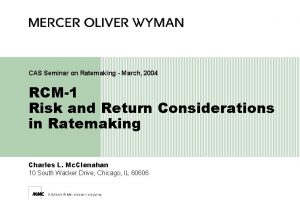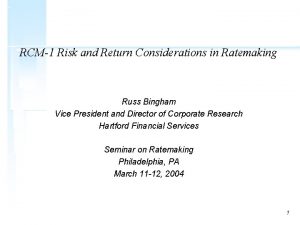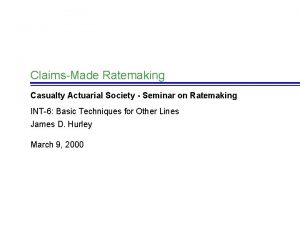CAS Ratemaking Seminar RCM1 Logic Fallacies and Paradoxes











- Slides: 11

CAS Ratemaking Seminar RCM-1 Logic, Fallacies, and Paradoxes in Risk/Profit Loading in Ratemaking: A Socratic Dialogue Introductory Remarks by Glenn Meyers ISO Innovative Analytics March 17, 2008

Insurer Risk and Capital Management Perspective • Risk based capital – The insurer's risk, as measured by its stochastic distribution of outcomes, provides a meaningful yardstick that can be used to set capital requirements. • Insurer risk management – The insurer manages its business to get the best return on its cost of capital.

Steps for Insurer Capital Management in Ratemaking • • Determine total capital for insurer Determine rate of return on that capital Allocate capital to business segment Calculate cost of business segment holding that allocated capital – My remarks today address this part of the problem.

Insurer Risk Management • Reserve Risk contributes to the need for capital and hence it contributes to the ($) cost of capital. • How long you need to hold capital is a consideration in determining an acceptable price.

The Cash Flow for Underwriting Insurance • Investors provide capital – Through the insurer they: • Receive premium income • Pay losses and other expenses • Receive investment income – Invested at interest rate i% • Release capital as liabilities become certain.

Net out the loss and expense payments • Investors provide capital – Through the insurer they: • Receive profit provision in the premium • Receive investment income from capital as it is being held. • Release capital as liabilities become certain. • We want the present value of the income to be equal to the capital invested at the rate of return for equivalent risk

Define Terms • Allocated Capital invested in year t • Provision for Profit • Insurer’s return on invested assets • Insurer’s target return on capital Ct P i r

Calculating the Profit Provision

Calculating the Profit Provision Another Formula

Sample Calculation Profit = 1, 348 = 2. 2% of Initial Liability

Prediction This how actuaries will include the cost of capital in future insurance costing. Main Obstacles to Overcome • Fuzzy relationship between risk and capital – Insurers are starting to build internal capital models – Examples EU Solvency II, British FSA, S&P • Quantification of all risks – – Underwriting risk and reserving risk Asset risk - Several commercial models Operational risk Other • Consensus – Will not come until above issues are substantially settled.
 In fair verona where we lay our scene meaning
In fair verona where we lay our scene meaning Paradoxes of green logistics
Paradoxes of green logistics Mechanical hound paradox
Mechanical hound paradox David lewis the paradoxes of time travel
David lewis the paradoxes of time travel The paradoxes of time travel david lewis
The paradoxes of time travel david lewis Paradoxes
Paradoxes Paradoxes
Paradoxes Assonance examples
Assonance examples First order logic vs propositional logic
First order logic vs propositional logic First order logic vs propositional logic
First order logic vs propositional logic First order logic vs propositional logic
First order logic vs propositional logic Combinational logic circuit vs sequential
Combinational logic circuit vs sequential





















